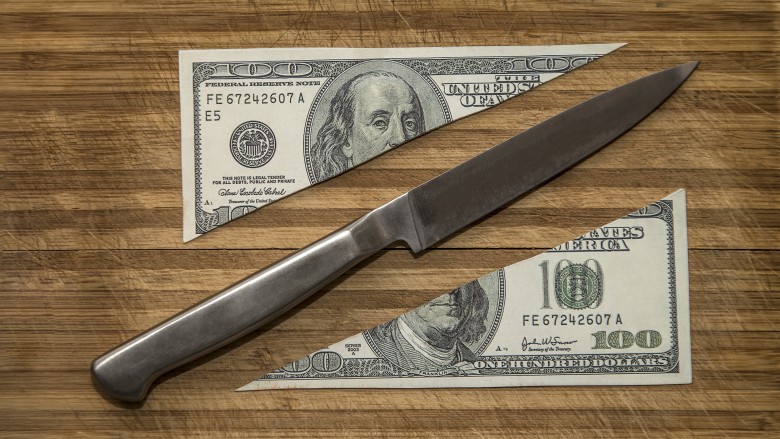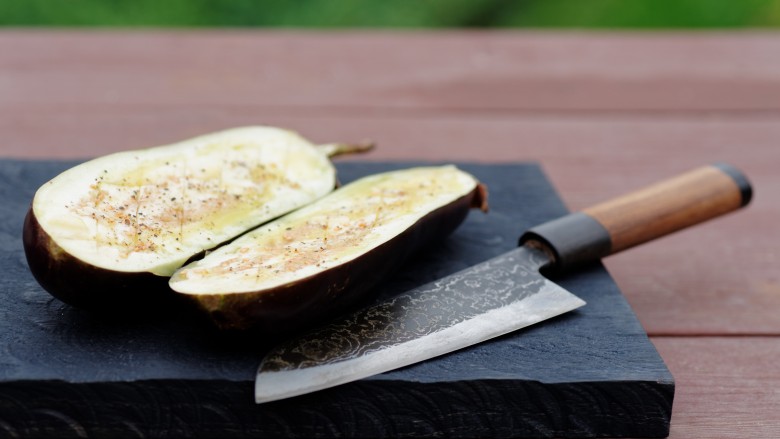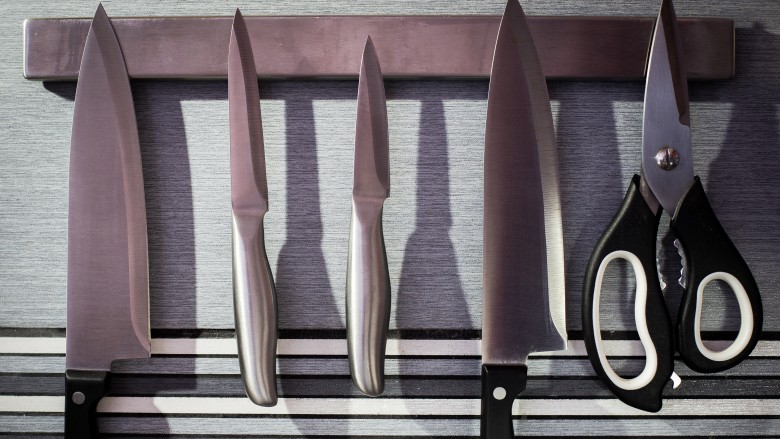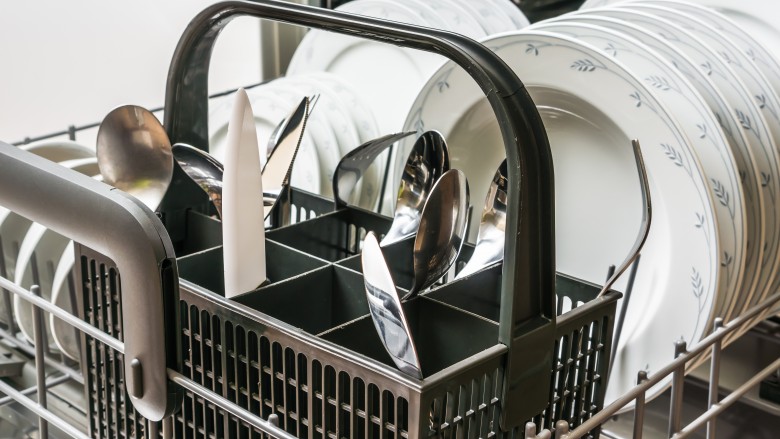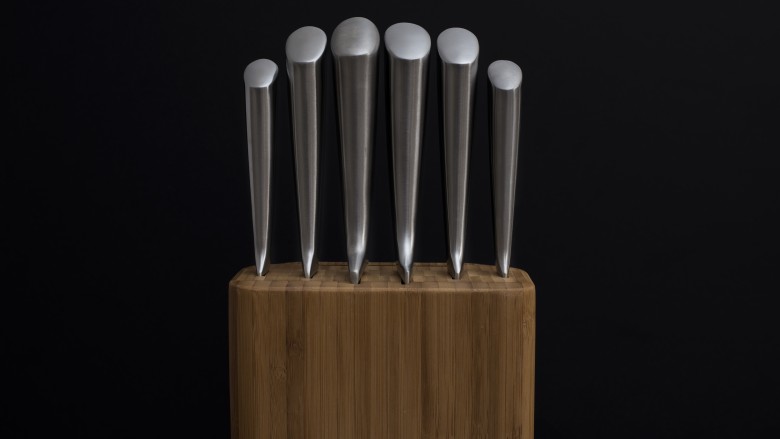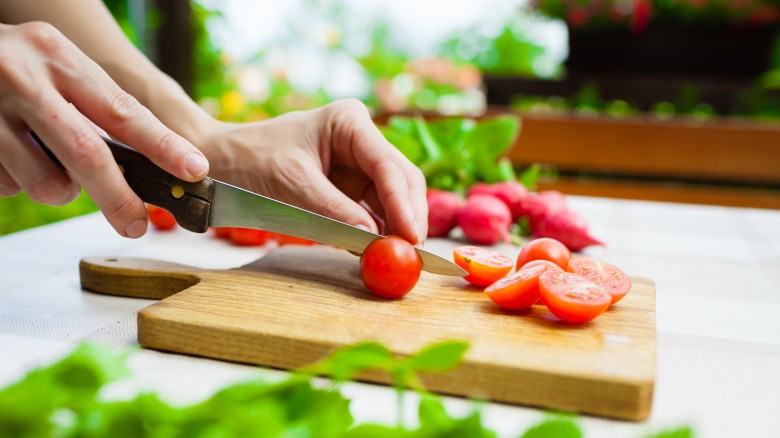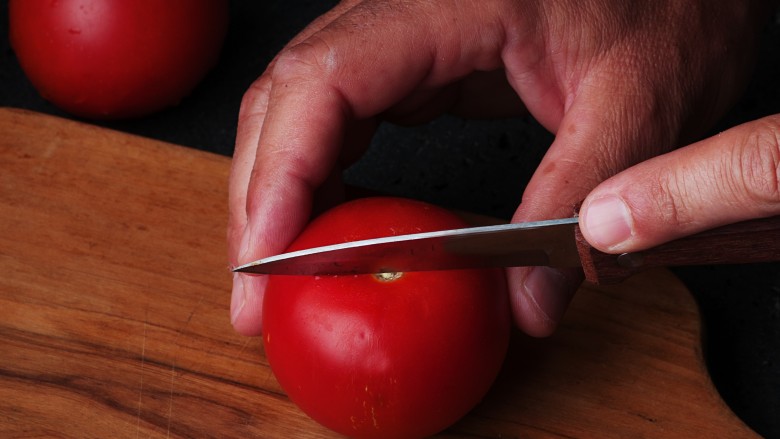Mistakes Everyone Makes With Kitchen Knives
Ask any good chef, and they'll tell you their knives are one of their most important tools. It's easy to make mistakes with them at every step along the way, and if you're not sure what you should (and shouldn't) be doing with your knives, you might find their lifespan is drastically reduced. From store to kitchen, let's talk about some of the most common mistakes people make, and how you can avoid them.
Spending too much or too little
A good set of knives can be one of the most puzzling purchases you ever have to make for your kitchen, and the incredibly wide range of prices means it can be difficult to know how much or how little you should spend. Generally, for the knives that are going to last a decent amount of time, hold their edge, and really be worth a place in your kitchen, you can expect to spend between $50 to $100 on each. If you're going to go on the higher end of reasonably affordable, you might be looking at up to $300 each.
Getting cheaper knives might be tempting, but you want something that's going to last. And, for most home cooks, it's not necessary to invest in the super-expensive, professional quality knives that are going to cost the same as a month's rent in any small to mid-size American city. Pay too much or too little, and you could be making a big mistake.
Not picking the right set
So, you have your price range in mind, and you want to keep from making a mistake when it comes to picking out the knives that are going to take a special place in your kitchen. If you invest in knives without keeping a few things in mind, you could find yourself suffering from a case of buyer's remorse.
First, pick your metal. Different knives have different pros and cons. For example, a knife made of high-carbon steel is going to be much sharper than a stainless steel knife, but it's going to be a lot more high-maintenance, too. You should also make sure you're comfortable holding the knife. Depending on the size of your hand, you might find you're more comfortable with a larger or smaller handle. Size matters when it comes to the blade, too, and if you're the type that's going to be cutting and prepping a lot of meats, you might want to invest in a longer blade.
Keep in mind that holding a knife in the store isn't the same as trying it out in your kitchen, so it never hurts to make sure you can return the knife if you find out it's not for you.
Not storing them right
We all know kitchen storage space is always at a premium, but not giving your knives special consideration is one of the biggest mistakes you can make. Take the time to store them right, and you'll find that not only will they keep their edge longer, but they'll always be close at hand and make kitchen prep a breeze.
Sometimes, you have no choice but to keep them in a drawer. Out of sight, out of mind, and out of the reach of exploring hands, it's a practical storage option that you can make better with one simple addition. Instead of putting them into a drawer loose, invest in an in-drawer storage unit to help keep them organized and to keep the blades from ricocheting off each other every time the drawer opens and you have to hunt for the right one. It'll help protect your fingers, too, and everyone could use a little extra kitchen safety!
Knife blocks are also a completely legitimate way to store your knives, but there's another common mistake people tend to make when they're putting their knives in or pulling them out. When you do, make sure you're pressing the blunt edge against the edge of the slot, as running the sharp edge against it isn't going to help you keep those blades in great shape.
One of the best ways to store your knives is also the way you're probably going to think looks the coolest, and that's on a magnetic strip mounted on the wall. Not only will it keep your knives off the counter, out of the way and organized, but you're going to be able to see the blade as well as the handle, so no more hunting for a knife that's been put back in the wrong place.
Not transporting them right
Ever find yourself getting ready to head over to a friend's outdoor BBQ, and just know you're going to end up doing some cooking? You might end up needing to take your knives somewhere to get them sharpened, too, and if you don't transport them the right way, there's no end to the amount of damage that can be done. From your fingers to the car to the knives themselves, there are a few simple ways to keep everyone and everything safe.
If you're going to be doing a lot of moving with them, invest in a knife roll. There are a ton of different options out there, and they're suitable for all kinds of knives and all kinds of situations. If you know you're only going to be carrying your chef's knife with you, for example, there's no need to go all out and get something insanely expensive. Just pick up a small knife roll, and it's an investment that will be well worth it!
If transporting your knives is a one-time excursion, you can also use a heavy kitchen towel carefully wrapped, folded, and secured with a rubber band.
Putting them in the dishwasher
It can be pretty tempting to throw your knives in the dishwasher with the rest of the meal's aftermath. But there are a few good reasons you should make sure you (or your kitchen helpers) don't take a shortcut with your knives.
Knives will rattle around, no matter where you put them. That can chip and dull the blades, and they could cause some serious damage to the other silverware they're bumping into. Since dishwashers rely on intense heat, there's also the possibility that's going to warp handles and loosen connections between the handle and the blade. It's not just your knives that can get damaged, either. If they're particularly sharp, they could cut through the plastic coating that's designed to protect your dishwasher racks from that same heat and water. That can lead to rusting and all sorts of problems, and no one wants to have to start replacing their dishwasher parts!
Not using the right one for the job
If you've ever grabbed a bread knife by accident when you're trying to cut a steak, you know how important it is to get the right knife for the job. Sometimes it's not always that clear, though, and it's harder to know just which knife is going to make your prep work easier.
For most home cooks, there are four different knives that will have you covered through pretty much any task. Knives can be insanely expensive, after all, and if you're going to make something of an investment in your gear, invest in these four and you'll be covered.
Your chef's knife is the one you see most often, and the reason for that is simply that it's the most versatile. It's great for things like prepping veggies, meat, and even chopping herbs, but since a good one should have an 8- to 10-inch blade, it's not great for more delicate tasks.
For all the tasks that are too small for a chef's knife to handle, use a paring knife. Think of things like cutting garlic or removing the stems from small fruits. Your serrated knife is more versatile than you think, too. Serrated knife? Bread knife, you're thinking? That's the one, but it's good for other things, too. Use this one for anything you have to saw rather than chop, and you can also use it for things like tomatoes and peppers. The serrated blade is going to help stabilize slippery surfaces, but the teeth will tear up small, delicate ingredients.
And lastly, pick up a boning knife. This one is going to make cutting things like meat, fish, and poultry infinitely easier, as it's designed to flex around bones and through cartilage. Make the investment once, and you'll have invaluable tools forever!
Using glass cutting boards
At a glance, glass seems like it might be the perfect solution to which cutting board you should get. But that's not the case, and the only thing you should be using that glass cutting board for is to put out for show!
There are a couple of reasons for this, and the biggest one is what it does to your knives. Sure, it's easy to clean and easy to sanitize — which is a major concern for all cooks — but that glass surface is going to dull your knives with shocking speed. Every time you cut, that sharp side of the blade is going to slide across your board, and it's going to damage your knife. Glass cutting boards can be slippery, as well, and that can make your kitchen unnecessarily dangerous. When it comes to glass, save those for the presentation trays!
Not keeping them sharp enough
Everyone treats their knives differently, and everyone's knives are different. That means there are no guidelines as to when you should think about taking your knives to be sharpened, but there are a few handy tests that will help you decide. Let them get too dull, and not only is it going to make your work a lot harder than it needs to be, but a dull knife can be just an dangerous as a sharp one. No one wants to cut themselves forcing a dull blade through a thick piece of meat, after all!
One of the easiest tests is just to take a sheet of paper, and see if your knife can slice through. Hold it up in front of you, and cut downward through the length of the paper. If your knife's in proper shape, it should cut easily. Another simple test is to take a tomato, and press the blade downwards against the skin. If it dimples before it cuts, it's time to get them sharpened. You can do the same thing with an onion, and if the knife slips off the peel before it cuts through the onion, you've got a dull blade in your hands.
Not honing your knives regularly and the right way
If you bought even a decent knife set, chances are you have a honing steel that came with it. You might even have purchased one separately, but how often do you pull it out and use it? It might seem like it's not doing a whole heck of a lot, so it can be an easy thing to forget about. That's a mistake, and it really is doing a lot. You just can't see it.
When you use your knife regularly, what you're actually doing is pushing the perfect edge of your blade ever-so-slightly to the side. That very edge is called the bevel, and when you use your honing steel, you're pushing everything back into alignment. It's not something you can actively see, and it happens on a microscopic level. But it can make you knife feel dull when it's really not, and honing should be done as a part of your regular kitchen maintenance.
While sharpening your knife takes off material and creates a fresh, beveled edge, honing works with what you already have to prolong the life of your knife and keep it in top shape in between taking it to get sharpened. There are a couple of different positions and ways you can use the honing steel (check out the video above for a run-through of these), and since everyone's different, experiment and find what's most comfortable for you.
Not holding them right
There are a few different ways professionals will hold their knives, and in the end, it's going to come down to what's comfortable for you. Many will hold not the entire handle, but choke up on the blade to afford the knife more stability. One thing a lot of people do that's a common mistake is extend one finger out to push down on the back of the knife blade. That's something that seems it should work, and you might think this is going to give you more control or stability, but the opposite happens.
If you do this, too, you're going to shift how you're applying pressure and guiding the knife. Finding a right and comfortable position is important from the get-go, since that's going to be what you get used to and what you keep doing. This position, though, is going to put pressure on your hand and, if you do it long enough, it can lead to serious problems that include carpal tunnel. It's also going to make your hand tire faster, and that's not a good thing when you're handling sharp knives. As for your other hand, always make sure the tips of your fingers are tucked under your knuckles when you're holding whatever you're cutting. It's not an intuitive thing to do, and it's a common mistake that can lead to cuts!

